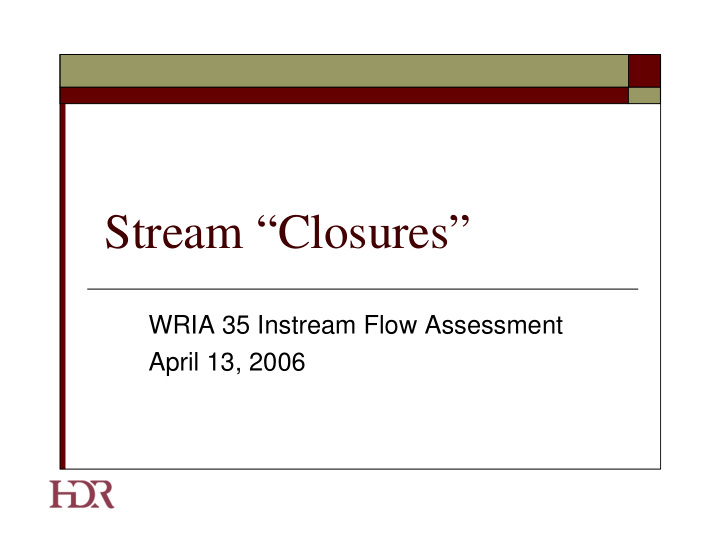



Stream “Closures” WRIA 35 Instream Flow Assessment April 13, 2006
Closures… …are applied to streams/basins where no surface waters (also � groundwater in hydraulic continuity with surface water) are available for appropriation. …protect stream flows from new appropriations, but do not � return (or add) flows to streams. …do not protect stream flows from potential harm caused by � water rights transfers or changes. SWSL (surface water source limitation) – compilation of flow limiting � actions taken on a particular body of water based on recommendations by WDFW as a result of a particular water right application. (RCW 75.20.050) WRIA 35 Instream Flow Assessment
Whereas, a minimum instream flow… …is “a water right for streams.” � …requires water use to cease whenever stream flows fall below a � certain level at a prescribed control point. …applies only to water rights “junior” to the minimum instream � flow priority. … requires continued stream flow monitoring for “enforcement.” � …provides flexibility for potential intra-basin transfers and other � future water rights decisions, including water rights for temporary, seasonal and storage uses. WRIA 35 Instream Flow Assessment
Integration of Closures into Strategy Where? Determine where closures are warranted � � Priority habitat areas where low flows are a “key” limiting factor � Potentially applicable in data-limited basins When? Generally, apply year-round closures � � Unless anticipated water use calls for seasonal closure and water use would not interrupt habitat forming flows Develop minimum instream flows where data is available � � Where a closure is warranted, Ecology prefers closures backed up with minimum instream flows WRIA 35 Instream Flow Assessment
Integration of Closures into Strategy Cont’d… Develop closure provisions (see later slides) � � Exemptions for domestic well use and other uses Review existing SWSLs and recommend changes, as � necessary � Ecology considers, but is not legally bound to accept them nor do they apply generally to all applications. Are the limitations appropriate? � � Should limitations be adopted into rule? WRIA 35 Instream Flow Assessment
Management Points with Closures Which streams have identified priority protection/ restoration � reaches? Where is flow identified as a primary limiting factor? � Refer to Table A-2 (updated from TM-2b) (hand-out) � Besides a closure, consider “no-action” or “further study” in � some areas due to data uncertainty. � Additional instream flow analysis? � Additional hydrologic data collection? � Additional groundwater availability study? WRIA 35 Instream Flow Assessment
Closure Period � Year-round closures are generally applied � Ease of enforcement � Interruptible rights are not desirable � Year-round fish presence � Closure would provide most benefit during flow transition period (early spring and late fall) � Where are seasonal closures appropriate? � Anticipated water uses? WRIA 35 Instream Flow Assessment
Provisions on Closures Watershed Planning Act requires strategies to supply water � for instream flows and future out-of-stream uses. Provisions can be developed to specify criteria allowing water � rights that are not conditioned or restricted by minimum instream flows or closures. � Set aside or reserve an amount of water for future use � Develop or modify closures that allow flexibility in addressing future water needs � Approve mitigation to offset adverse flow effects from new permits � Overriding consideration of public interest (OCPI) � Allow for changes to existing water rights WRIA 35 Instream Flow Assessment
Using Reservations � Reservations are established for specific uses, with specified amounts for each jurisdiction and basin. � Applicant would need to evaluate all potential sources and demonstrate why reservation is needed. � Off-setting or mitigating actions would be required for potential stream flow impairment. WRIA 35 Instream Flow Assessment
Reservation for Exempt Wells � Exempt wells are not exempt from priority date system, closures, or impairment restrictions. � Considerations: � Reservation should be consistent with land use plans (i.e. zoning densities). � Ecology would track number of wells against reservation � Well completion should account for potential surface-ground water interactions � Wells should be metered and water usage reported WRIA 35 Instream Flow Assessment
Reservations for Exempt Wells � Calculating reservation value � Zoning densities � Lot size limits or irrigated land limits (e.g ½ acre) � Average annual use rate (e.g. 800 gpd) WRIA 35 Instream Flow Assessment
Reservations for M&I � Existing water rights are adequate to meet projected demands for planning period � Exception maybe Town of Asotin � Other unaccounted-for users or anticipated users? WRIA 35 Instream Flow Assessment
Recommend
More recommend